List of Authors
>>About this blog
Recent blog post
|
[Ryokichi]
September 26, 2014 16:49
I also went to two events that had already been talked about, the All Japan Tug of War Festival and the Oedo Festival Bon Dance Festival. This time, I would like to write a blog that summarizes two events based on the location of Hamacho Park.
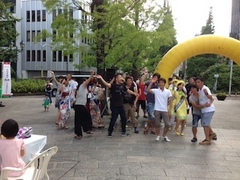
The All Japan Tug of War Festival is held mainly in the gymnasium, but stores are lined up from the entrance of Hamacho Park. From the yellow gate as shown in the photo, park visitors to enjoy the festival without losing the main tug of war are enjoying the summer time.
Eating and drinking at restaurants is fun, but various events were also wonderful.
Regularly, participants of the opening of the store, Miss Chuo-ku, and other people danced in music (AKB48), and were excited. Kendama Champion decided on a flashy technique, which was also receiving great attention. The entertainer of Yoshimoto also creates a peaceful atmosphere. What should be noted is the sumo wrestler. A wrestler from the Arashio room in Hamacho is acting as a chanko pot. The taste is good. It will entertain us at the event.
In addition to these, the Chuo-ku Tourism Association gathers children with traditional toys, water guns, kendama, etc.
I took three yo-yo-yo at the booth in Chuo-ku. This is a new record. Moreover, it was still likely to be taken at the time of taking three, but he declined. I used to be poor in the past, but suddenly it got better.
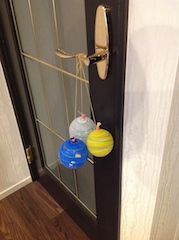
It is held in the midsummer after the tray and has a slightly sober impression, but it is a recommended event that is kind to everyone who comes and everyone.
In fact, I spent many hours without knowing the excitement of the tug-of-war tournament in the outside fun. sumo wrestlers' hot pot, Yakisoba, Beer...
What was the tournament like? I forgot the original interview and ended that day.
The next event of the tug-of-war tournament is the Bon Dance Festival the following week.
What is overwhelming here is the amount of people and store openings. It's getting bigger compared to the previous week's events. Fortunately, we were blessed with the weather, and this was also exciting.
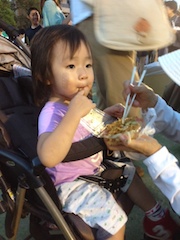 From children to grandfathers and grandmothers, I met wonderful smiles. From children to grandfathers and grandmothers, I met wonderful smiles.
Hamacho Park is a wonderful place as a space. I feel that I will come to the Bon Dance Festival. The venue is a playground, but at the end of the view is the bank of the Sumida River, where the highway passes. Because of the highway, the river is not completely visible, so it is a little different space from the river. However, there is a large space of the river above.
This space, which seems to be open and feels like a special space. Isn't it ideal for Bon Odori, which goes away from everyday life for a while?
I couldn't think of such a meaningful thing, but when I was vague, the evening was night.
The two events will meet both to excite the second half of summer. The fireworks display was disappointing this year, but various events in Chuo-ku will not get bored.
After mid-August, the day becomes shorter, and the season gradually becomes autumn. I'm a little lonely.
Nevertheless, there are festivals and events that are tasteful in autumn in autumn, so I would like to go again.
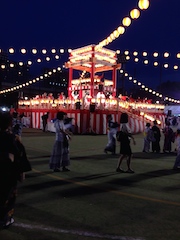
[Kenken]
September 25, 2014 09:00
The other day, as a "boat sightseeing," I had a small cruise on the Nihonbashi River starting from Nihonbashi, returning from the Sumida River to the Kanda River and the Nihonbashi River to Nihonbashi.
The scenery seen from the water and the boat was certainly new and fun, but I thought, "Let's see various spots around the river", so after a long absence I took an "early walk"
The start of this day is from Toyomi Bridge. 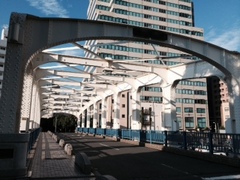 The shop you care about at the foot of the bridge is Mile Post (Shinkawa 1-29-6). A number of beautiful bicycles through the window. Yes, I'm worried. I'd like to ask you slowly next time. The shop you care about at the foot of the bridge is Mile Post (Shinkawa 1-29-6). A number of beautiful bicycles through the window. Yes, I'm worried. I'd like to ask you slowly next time.
It is said that the next Mile Post Cafe is currently closed. I would like to ask you when this is also reopened.
 
There is a little green on the left side of Toyomi Bridge across the Hakozakicho River. There was a notice here that there was a thing called Takao Inarisha (10-7, Nihonbashi-Hakozakicho). Now there is a small torii, worship hall, about 100 meters northwest of here.
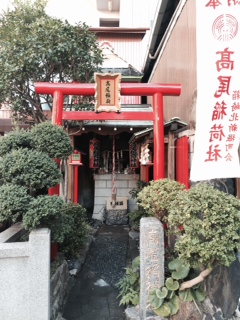 The history of this shrine is ruined. The history of this shrine is ruined.
A prostitute named "Dayu Takao" tried to pile up a lot of money and make it his own (although the name is also specified in the guide of the shrine.)...As a result of rejecting the invitation, he was killed in the Sumida River and moved to Kawanaka. A few days later, a monk who had a hermitage nearby buried the body launched on the riverbank, and people who knew the background built the shrine and worshiped it. The stop is amazing that the body (skull) is worshiped as a god of worship.
Next is Minato Bridge. Rather than a photo of Minato Bridge itself, Toyomi Bridge, which also took pictures of Mizkan's large building from Minato Bridge, might be better.
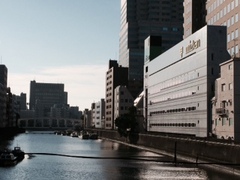 On the way to Kayaba Bridge, you will pass through the Kirin Nihonbashi Building (2-5 Nihonbashi Koamicho). It seems that there is a "Draft Masters School" here. On the way to Kayaba Bridge, you will pass through the Kirin Nihonbashi Building (2-5 Nihonbashi Koamicho). It seems that there is a "Draft Masters School" here.
I'd like to go to Kirin Beer, but it seems to be for restaurants....(laughs).
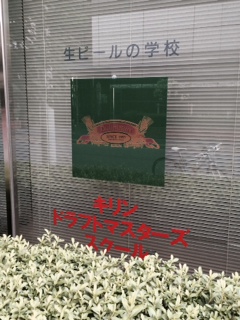 So Chiba Bridge. Beyond the bridge, you can see a large building of Kao (1-14-10 Nihonbashi Kayabacho) on the Kayabacho side. So Chiba Bridge. Beyond the bridge, you can see a large building of Kao (1-14-10 Nihonbashi Kayabacho) on the Kayabacho side.
In the opposite direction, there is also a big building of Pentel (7-2 Nihonbashi Koamicho). (I forgot to take a picture)
Well, it might be better for Pentel to say that it is under the next armor bridge than Kayaba Bridge.
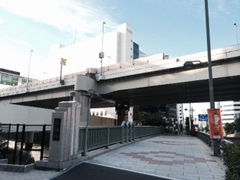
When you cross the armor bridge, you will see a magnificent building of the Tokyo Stock Exchange in front of you.
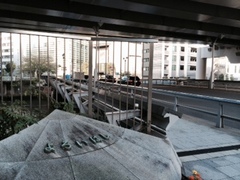 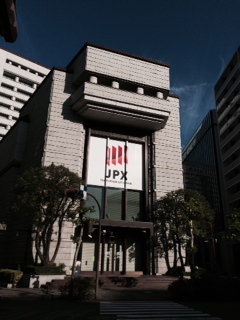
From the viewpoint of the exchange, Kabuto Shrine (Nihonbashi Kabutocho 1-12) is located on the river side.
The building itself seems to be new in 1971, but the "Kabutoiwa" in the precincts dates back to the role of the previous nine years (1050), and the name of the town is also This rock It looks like a very deep shrine that was named after it.
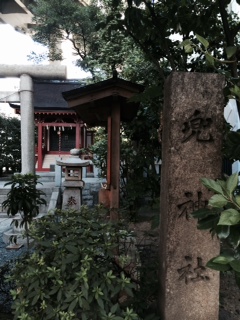 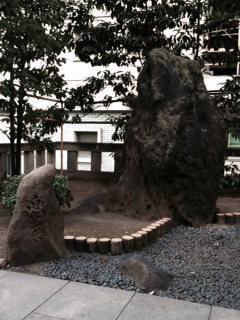
When I came to the next Edobashi and the monument of "the birthplace of mail" in front of it, and the Nihonbashi Post Office with the statue of "Maejima Mitsu", this time is out of time.
Next time, let's start around Edobashi and Nihonbashi.
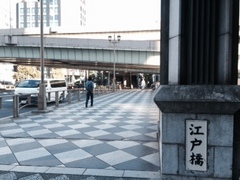 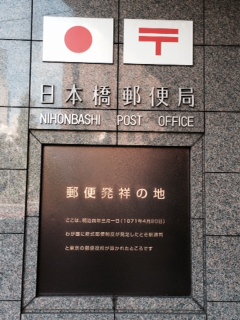 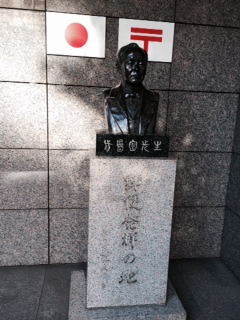
[Sam]
September 22, 2014 14:00
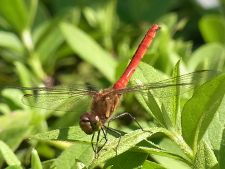 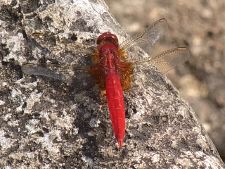
Akiakane Dragonfly
This morning, while strolling through Tsukuda Park, I encountered two kinds of "red dragonflies": Akiakane and Shojo dragonflies.
Unexpectedly today, September 21, "Akiakane Hatsumi" was reported in the Tokyo region.
It is 4 days later than normal and 3 days later than last year.
Akiakane emerges from early June to early July, and once moves to the mountains (the body color at this time is pale yellow), but in autumn, the abdomen becomes peculiar red and returns to the flat ground It is said that
The day when this abdomen first saw an individual with a red abdomen is called the "first viewing day", and is counted as one of the "biological seasonal observation" of this season.
 Akiakane is one of the representative species of so-called "red dragonflies". Akiakane is one of the representative species of so-called "red dragonflies".
"Red Dragonfly" is a general term for red dragonflies of the body color, and generally refers to the genus Dragonfly, but the body color is yellow, such as red dragonflies other than the red dragonflies (scarlet dwarf, Shojo dragonflies, Benite dragonflies, etc.) that appear in flocks from the end of summer are also called "red dragonflies".
Natsu Akane, which resembles Akiakane, is said to have no difference in the overall habitat itself, appears on flat ground throughout the entire period, and is classified by redening the head, chest, and abdomen.
By the way, the "red dragonfly" appearing in the nursery rhyme "Akatonbo" appears in the nursery rhyme "Usbaki dragonfly", which is often seen in flocks from the viewpoint that it looks like a piggyback child, and "Akiakane" from the habit of stopping at the end of the pole It seems that there is a high possibility.
[Dimini ☆ Cricket]
September 21, 2014 17:00
If it doesn't fall, it looks whisper in your eyes, but you'll be surprised by the sound of the wind
(Toshiyuki Fujiwara, Kokin Wakashu)
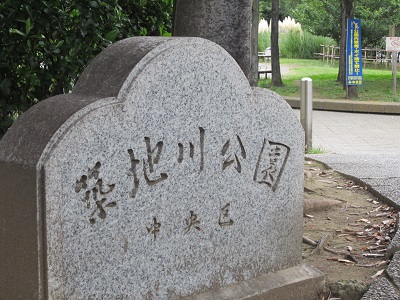 When I thought it was getting cooler in the morning and evening, the autumn scenery was already spreading here in Tsukiji River Park in Akashicho. When I thought it was getting cooler in the morning and evening, the autumn scenery was already spreading here in Tsukiji River Park in Akashicho.
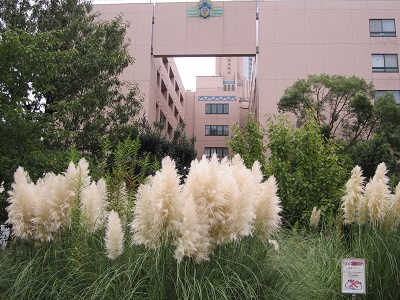 Pampas grass, also known as Shiroganeyoshi. It is a plant of the family Riceaceae and has a large presence. Pampas grass, also known as Shiroganeyoshi. It is a plant of the family Riceaceae and has a large presence.
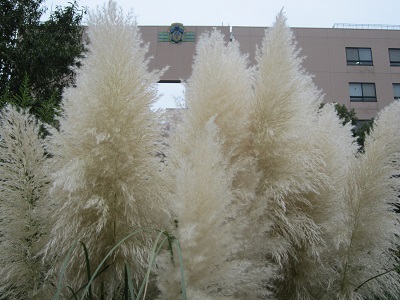 In naturalized species, the appearance of cream-colored spikes swaying in the wind in the backlight creates the autumn of Japan. In naturalized species, the appearance of cream-colored spikes swaying in the wind in the backlight creates the autumn of Japan.
[Sam]
September 17, 2014 14:00
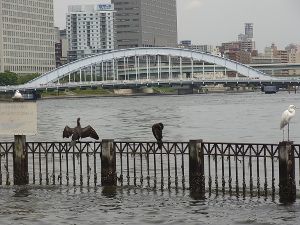 The Sumida River diverts east at Tsukuda 2-chome, upstream of Chuo-ohashi Bridge, and is connected to the Spring (Haru) shipping river. Ishikawajima Park is located. The Sumida River diverts east at Tsukuda 2-chome, upstream of Chuo-ohashi Bridge, and is connected to the Spring (Haru) shipping river. Ishikawajima Park is located.
With the adoption of Super dike, it is integrated with the open space, ensuring hydrophilicity so that it can interact with water, and is crowded with people who enjoy jogging and walking.
A lot of water birds fly, and at low tide, they can be seen foraging on the shore where water has drawn.
The upper left photo shows high tide. From the left, black-tailed gull (on the signboard), Kawau great egret.
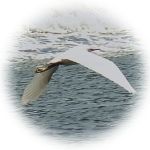 Among them, the elegance of herons attracts attention from its elegant appearance. Among them, the elegance of herons attracts attention from its elegant appearance.
Shirasagi is a general term for great egret and little egret, which are common in Japan.
In addition, white type of hare, amagi, black heron, etc. is added.
Each is identified by size, toe color, presence or absence of crowns, etc.
In September, you can see great egret little egret, dressed in winter feathers, up close on the waterfront terrace.
great egret: During summer feathers, the black beak changed to yellow.
little egret: During summer feathers, two prominent long crown feathers are short and inconspicuous.
I feel the turn of the season in such a place.
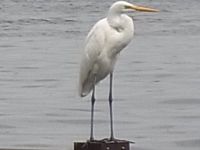 
great egret little egret
[Sam]
September 12, 2014 09:00
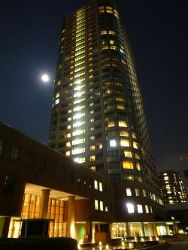 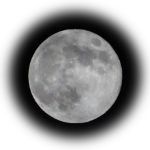 This year, September 8 is August 15 in old calendar, and the mid-autumn moon (15 nights). This year, September 8 is August 15 in old calendar, and the mid-autumn moon (15 nights).
Last year was September 19, and last year it was September 30, so it arrived a little earlier.
Unfortunately, it was raining in the Tokyo area.
However, the fact that the moon is hidden by clouds etc. on the mid-autumn night is called "no moon", and the rain is called "rain moon", and it is said that he enjoyed the subtle atmosphere ... .
The following day, September 9th, turned around, and the moon viewing day.
A round "moon" shines in the clear autumn sky, beside the window lights of the apartments of Okawabata River City 21.
Since the phases of the moon are not perfect for one month, the mid-autumn moon (15 nights) is not necessarily the full moon, and in fact, September 9 is the full moon this year.
"Otsukimi", which has been handed down to the present day, is thought to have been spread by combining the custom of admiring and loving the ancient moon and the ritual of praying for good harvest and thanks to the harvest season of crops.
"There are many months to see the moon in the moon, but the moon to see the moon is the moon of this month" (without reading)
|
Links
|
 From children to grandfathers and grandmothers, I met wonderful smiles.
From children to grandfathers and grandmothers, I met wonderful smiles.


















 Akiakane is one of the representative species of so-called "red dragonflies".
Akiakane is one of the representative species of so-called "red dragonflies".






